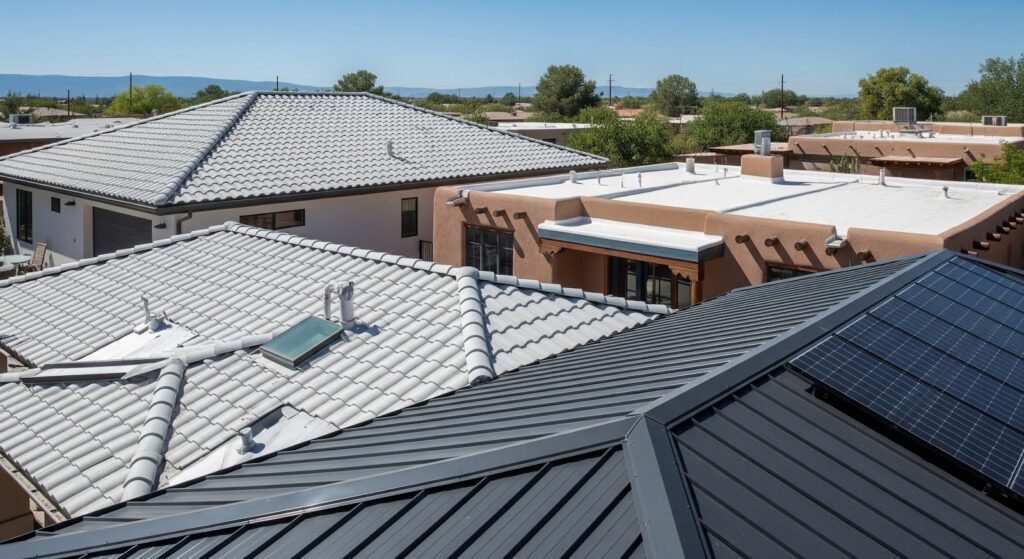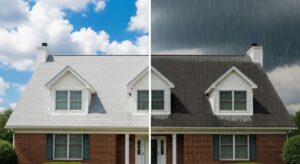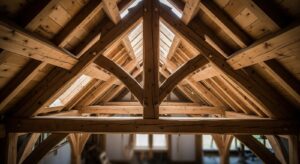Living in a hot climate means fighting high energy bills every summer. The right heat resistant roofing can cut your cooling costs by 30% and keep your home comfortable when it’s 100°F outside.
Your roof is your home’s first defense against extreme heat and UV rays. Pick the wrong material and you’ll pay for it every month in energy bills. This guide shows you the best roofing materials for hot climates that actually work for residential homes in desert and tropical regions.
Why Your Current Roof Might Be Costing You Money
Most traditional residential roofing materials absorb heat like a sponge. Conventional dark-colored roofs can reach temperatures of 150°F or more on a sunny summer day. All that heat goes straight into your house, making your HVAC system work overtime.
According to the Lawrence Berkeley National Lab Heat Island Group on a typical summer afternoon a clean white roof that reflects 80% of sunlight will stay about 50°F cooler than a grey roof that reflects only 20% of sunlight.
The best energy-efficient roofing materials for hot climates do two things:
- Reflect solar radiation away from your home
- Release any absorbed heat quickly (high thermal emittance)
Research-Backed Savings You Can Expect
Department of Energy Studies Show: The Department of Energy confirms that cool roofing systems are designed to reflect more sunlight than a conventional roof, absorbing less solar energy. Recent studies found cool roofs can reduce cooling energy costs by 15-30% in hot weather climates.
Real-World Energy Savings: Research from multiple climate zones shows energy savings per roof area ranged from $0.126/m2 in West Virginia to $1.14/m2 in Arizona, averaging $0.356/m2 annually across the United States.
Top 5 Energy-Efficient Roofing Materials for Hot Climates
1. Clay Roof Tiles – The Heat Fighter
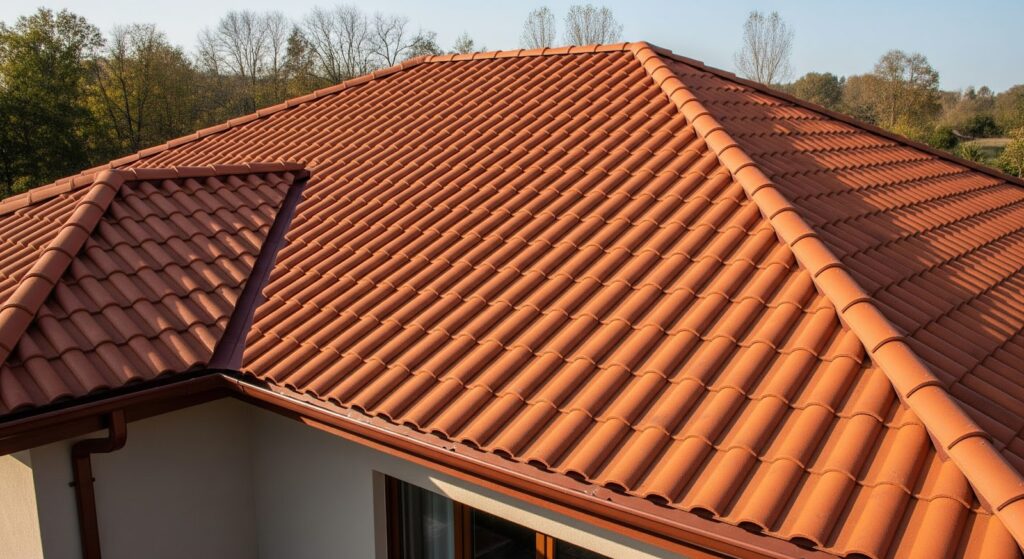
Clay roof tiles have kept homes cool for thousands of years. They’re natural heat deflectors that work in two ways:
How they work:
- Light colors reflect 70% of sun’s heat (high solar reflectance)
- Curved shape creates cooling air gaps underneath
- Thick material stores heat during day, releases it at night
What you get:
- 20-30% lower cooling bills
- 50+ year lifespan
- Fire resistant roofing option
- Low maintenance requirements
| Clay Tiles Features | Details |
| Cost | $8-15 per square foot |
| Weight | 600-800 lbs per square (heavy) |
| Colors Available | Red, brown, tan, white, gray |
| Installation Time | 3-5 days for average home |
| Energy Savings | $400-800 per year |
| Warranty | 30-50 years material |
| Wind Resistance | Up to 150 mph when properly installed |
| Maintenance Cost | $200-500 every 10 years |
The catch: Higher upfront cost and your house needs strong support for the extra weight.
Best for: Homes in dry heat areas like Arizona, Nevada, and Southern California with Spanish or Mediterranean architecture.
2. Metal Roofing Systems – The Heat Reflector
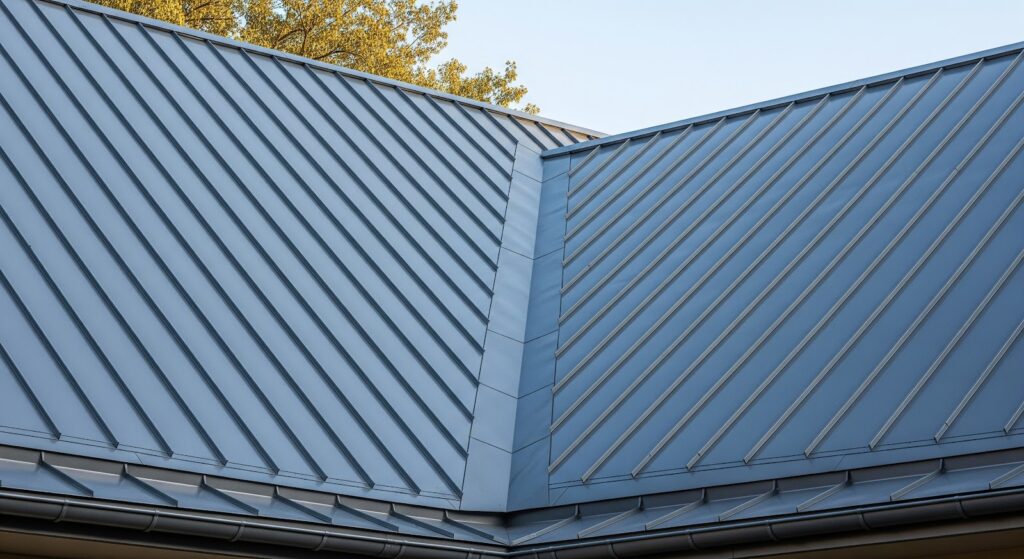
Modern metal roofing systems aren’t your grandfather’s tin roof. Today’s reflective metal roofing reflects up to 70% of heat and comes in dozens of colors.
Why it works:
- Special cool roof coatings bounce heat away
- Metal releases heat fast when sun goes down
- Light colors work best but even dark metal beats asphalt shingles
What you save:
- 25-40% on air conditioning costs
- 40-70 year lifespan
- No fire risk
- Handles 140+ mph winds
| Metal Roofing Features | Details |
| Cost | $7-14 per square foot |
| Weight | 50-150 lbs per square (light) |
| Materials | Steel, aluminum, copper |
| Installation Time | 1-3 days for average home |
| Energy Savings | $600-1,200 per year |
| Warranty | 30-50 years material |
| Noise Level | Quiet with proper insulation |
| Maintenance Cost | $100-300 every 15 years |
The downside: Can be noisy in heavy rain without proper attic insulation.
Best for: Any hot climate region, especially areas with severe weather and storms.
3. Concrete Roof Shingles – The Budget Winner
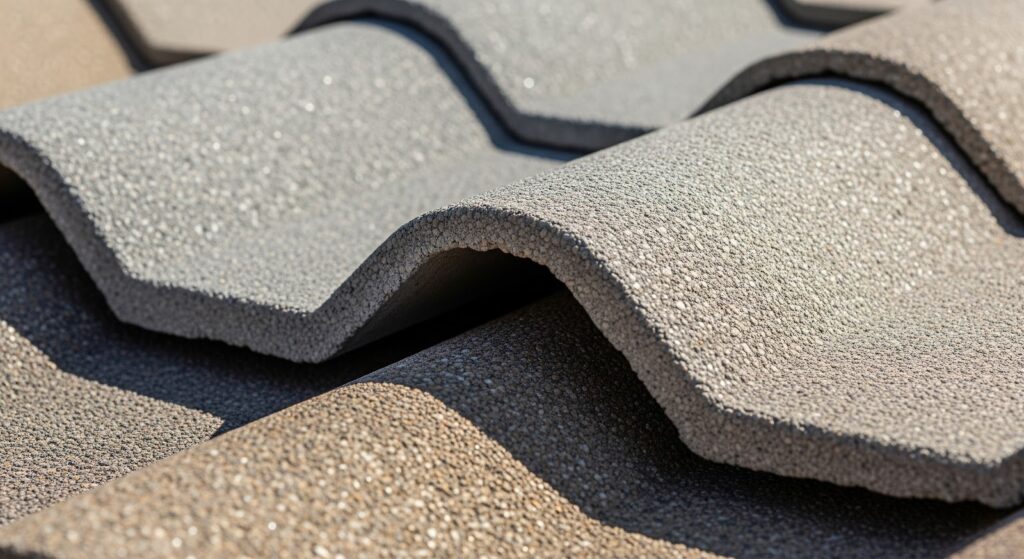
Want the look of clay tiles without the price? Concrete roof shingles give you similar cooling power at half the cost.
Key benefits:
- Reflects 25-77% of heat (depends on color selection)
- Costs 40% less than clay tiles
- Fire resistant material
- 30-50 year lifespan
| Concrete Shingles Features | Details |
| Cost | $4-9 per square foot |
| Weight | 300-400 lbs per square (medium) |
| Styles | Flat, curved, slate-look |
| Installation Time | 2-4 days for average home |
| Energy Savings | $300-600 per year |
| Warranty | 30-50 years material |
| Color Options | 20+ standard colors |
| Maintenance Cost | $150-400 every 10 years |
Smart tip: Choose light-colored shingles. White concrete shingles reflect 77% of heat while dark ones only reflect 25%.
Best for: Budget-conscious homeowners who want performance without premium prices.
4. Cool Roof Coatings – The Quick Fix
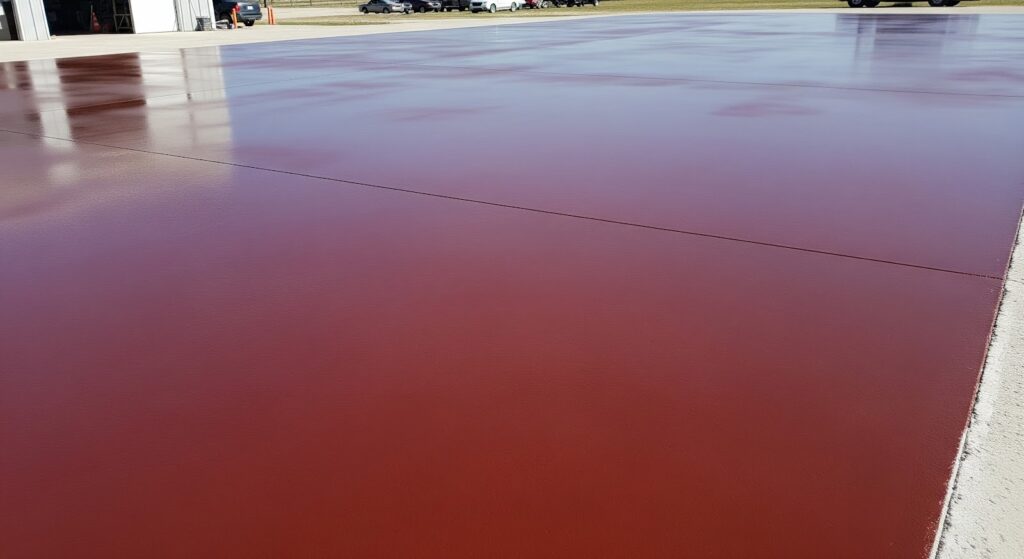
Already have an existing roof but want better cooling? Cool roof coatings can turn any roof into a heat reflector for a fraction of replacement cost.
How it works:
- Special white coating reflects 50-90% of heat
- Goes over most existing roofing materials
- Protects from UV damage and weathering
What it costs:
- $1-3 per square foot
- Saves 10-30% on cooling
- Lasts 5-15 years
| Cool Roof Coatings Features | Details |
| Cost | $1-3 per square foot |
| Weight | Adds almost no weight |
| Coating Types | Acrylic, silicone, polyurethane |
| Installation Time | 1-2 days for average home |
| Energy Savings | $200-500 per year |
| Warranty | 5-15 years material |
| Reapplication | Every 10-15 years |
| Best On | Flat roofs, metal roofs |
Perfect for: Flat roofs, metal roofs, or when you’re not ready for full roof replacement.
5. Green Roofing Systems – The Natural Cooler
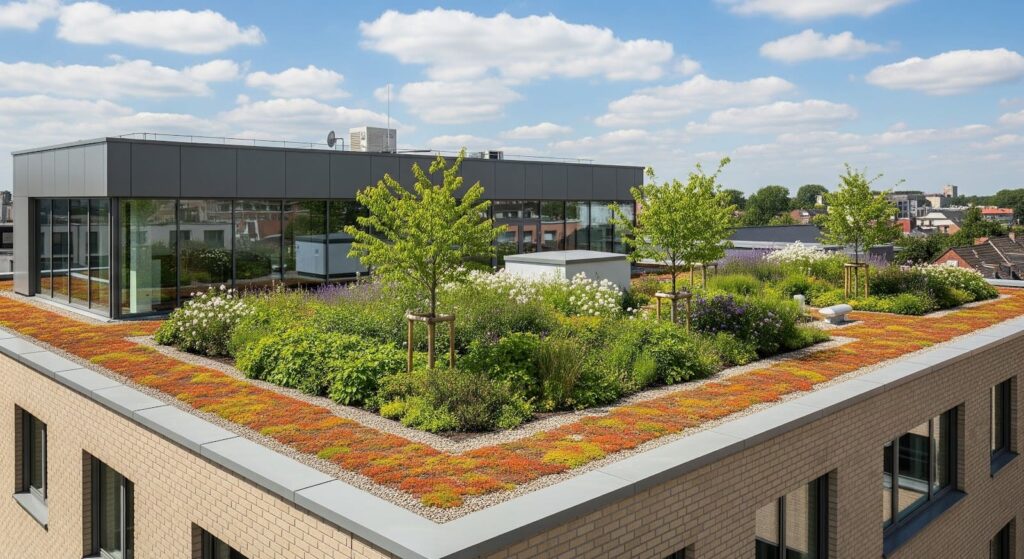
Green roofing systems use plants to naturally cool your home. They’re expensive but incredibly effective in the right situation.
How they cool:
- Vegetation blocks 100% of direct sun
- Water evaporation creates cooling effect
- Soil provides natural insulation
The numbers:
- Surface temps 60°F cooler than regular roofs
- 15-30% energy savings
- 30+ year lifespan
| Green Roofs Features | Details |
| Cost | $15-50 per square foot |
| Weight | 80-150 lbs per square foot (very heavy) |
| Types | Extensive (thin) or intensive (thick) |
| Installation Time | 1-2 weeks for average home |
| Energy Savings | $400-900 per year |
| Warranty | 20-30 years waterproof membrane |
| Maintenance | $2-5 per square foot annually |
| Water Needs | Irrigation system required |
Reality check: High cost and needs ongoing plant care and maintenance.
Best for: Flat roofs on homes where you want environmental benefits and sustainability.
Price vs Performance: What You Need to Know
| Material | Upfront Cost | Energy Savings | Lifespan | Best Value |
| Clay Roof Tiles | High | 20-30% | 50+ years | Long-term |
| Metal Roofing Systems | High | 25-40% | 40-70 years | Best overall |
| Concrete Shingles | Medium | 15-25% | 30-50 years | Budget choice |
| Cool Roof Coatings | Low | 10-30% | 5-15 years | Quick fix |
| Green Roofing | Very High | 15-30% | 30+ years | Environmental |
How to Choose the Right Material for Your Home
For maximum energy efficiency: Reflective metal roofing or light-colored clay tiles For tight budgets: Concrete shingles or cool roof coatings
For flat roofs: Cool roof membranes or green roofs For home style: Clay tiles or concrete shingles in various color options
What Roof Color Should You Choose?
Color selection makes a huge difference in hot climates and affects your home’s energy efficiency:
- White/Light Gray: Reflects 70-80% of solar heat
- Tan/Beige: Reflects 40-50% of solar heat
- Red/Brown: Reflects 30-40% of solar heat
- Dark Colors: Reflects 20-30% of solar heat
Pro tip: Even a dark-colored metal roof with special coatings beats regular dark asphalt shingles.
Installation Tips That Save Money
- Proper attic insulation: Keeps reflected heat from entering through the roof deck
- Good roof ventilation: Lets hot air escape from attic space
- Quality underlayment: Protects against heat damage to roof structure
- Professional roofing contractor: Improper installation voids warranties
Government and Research Support
EPA Heat Island Reduction Program The Environmental Protection Agency actively promotes cool roofing technology as a key strategy to reduce urban heat islands. The EPA confirms that cool roofs work by reflecting more solar energy away from the roof surface, reducing heat absorption.
Department of Energy Cool Roof Initiative The DOE is using cool roofing technology in federal buildings and reports that one installation is expected to save taxpayers $8,000 annually in energy cost reductions. The Department aims to dramatically increase the number of federal buildings using this proven technology.
Lawrence Berkeley National Laboratory Research Scientists at Berkeley Lab’s Heat Island Group provide the technical foundation for cool roof standards. Their research shows that solar reflectance and thermal emittance are the two critical properties to consider when selecting effective roofing materials for hot climates.
FAQs About Roofing Materials for Hot Climates
How much can I really save on cooling costs?
The best roofing materials for hot climates save 20-40% on cooling bills. A typical home might save $500-1,200 per year. Your exact savings depend on your home size, current roof, and local energy costs.
Do light-colored roofs always work better?
Usually yes, but material matters too. A white metal roof reflects more heat than white asphalt shingles. The key is both high reflectance (bounces heat) and high emittance (releases heat).
Will my roof structure support heavier materials?
Clay tiles and slate are heavy. Most homes built after 1970 can handle clay tiles, but get a structural engineer to check first. Metal roofing is light and works on almost any structure.
What about maintenance in hot climates?
Metal roofs need almost no maintenance. Clay tiles may need occasional replacement of broken pieces. Cool coatings need reapplication every 10-15 years. Green roofs need regular plant care.
Are there rebates for cool roofs?
Many utilities offer $0.10-0.75 per square foot rebates for ENERGY STAR cool roofs. Some areas have additional state rebates. Check with your utility company first.
Can I install over my existing roof?
Some metal roofs and cool coatings can go over existing roofs. This saves removal costs but check local building codes first. Most areas limit you to 2-3 roof layers total.
How long do these materials last in extreme heat?
Quality materials handle heat well:
- Metal roofing: 40-70 years
- Clay tiles: 50-100 years
- Concrete: 30-50 years
- Cool coatings: 10-20 years
The key is professional installation and choosing materials rated for your climate zone.
What’s the payback period for cool roofs?
Metal roofs typically pay for themselves in 8-15 years through energy savings. Clay tiles take 12-20 years. Cool coatings pay back in 2-5 years. Factor in increased home value for the full picture.
Do these roofs work in humid heat?
Yes, but ventilation becomes more important. Metal roofs excel in humid climates because they don’t absorb moisture. Proper attic ventilation prevents condensation issues.
Should I replace my roof now or wait?
If your current roof is over 15 years old and you’re spending $200+ monthly on cooling, replacement makes sense. If your roof is newer, consider cool roof coatings as an interim solution.
Bottom Line: What Works Best
For most homes in hot climates, metal roofing gives you the best combination of energy savings, durability, and long-term value. It costs more upfront but pays you back through lower energy bills and increased home value.
If budget is tight, concrete shingles in light colors offer solid performance at a reasonable price. For existing roofs, cool coatings provide immediate relief at minimal cost.
Helpful Resources and External Links
Government Resources:
- ENERGY STAR Cool Roofs Program – Official certification standards and product listings
- Department of Energy Cool Roofs Guide – Comprehensive information on cool roof benefits
- EPA Heat Island Reduction – Technical guidance on cool roof implementation
Research and Technical Information:
- Lawrence Berkeley National Lab Heat Island Group – Latest cool roof research and standards
- National Renewable Energy Laboratory (NREL) – Advanced energy technology research and data

